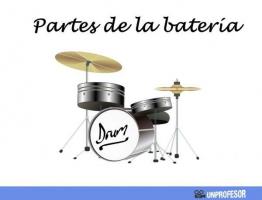The different types of musical PERCUSSION INSTRUMENTS
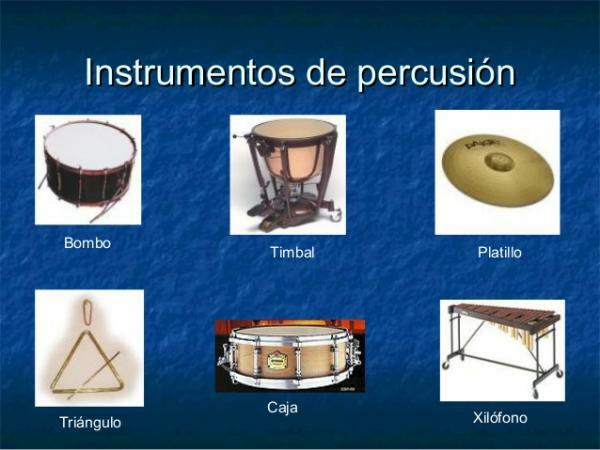
Image: Music-Wordpress
There is a factor that has been around since the beginning of humanity: curiosity. Our actions have led us to understand that for each one of them we get a reaction, and this has made us aware of the power we have for creation. It is the case of art.
In music it is believed that the first "instrument" must have been an object with which our distant ancestors struck something else and realized that they had the ability to produce sound. Thousands of years later, with evolution and accumulated knowledge, we have been able to shape these instruments invented mechanisms to increase the variety of sounds that we can use to create music.
In this lesson from a TEACHER we will talk about the oldest types of musical instrument, having already evolved to how we know them today: percussion musical instruments.
Index
- Classification of musical instruments
- The concept of percussion and rhythm
- Types of percussion instruments
- Other categories of percussion musical instruments
- Percussion instruments of the world
Classification of musical instruments.
There are hundreds of different musical instruments that come in various shapes, sizes, and materials. Each instrument is a unique invention and its operation as well, therefore the sounds they produce are different. Thanks to this variety, we can have music with rich textures.
Musical instruments are classified depending on their technique for producing sound. In general we can say that the instruments are classified as: string instruments (the sound comes from strings of different lengths), wind instruments (breathing is used to produce sound) e percussion instruments.
At present we also find the electronic instruments, which differ by not being analog like the rest, but uses synthesis to produce artificial sounds.
The concept of percussion and rhythm.
Percussion comes from the word "percuss" which means to give one or more blows. So a percussion instrument is anyone who produces sound when struck. When we strike a percussion instrument we can do it directly with our hands, and in other cases, with a piece specifically designed for the instrument to be played.
The main function of a percussion instrument is create or support rhythm, which is a staple in music. Rhythm is a sound succession, regardless of their height (tuning). In the staff we can visualize the rhythm horizontally, when there is one note after another and that together they can have the same or different value.
It is the rhythm in music that is responsible for the continuity and the perception of speed (we can feel music is slow or fast) and tension (feelings related to relaxation, energy or urgency). It also constitutes a musical basis for harmonic and melodic instruments to develop more solidly and accurately. Finally, the percussion instruments they are very useful to give you strength or impetus at a specific moment.
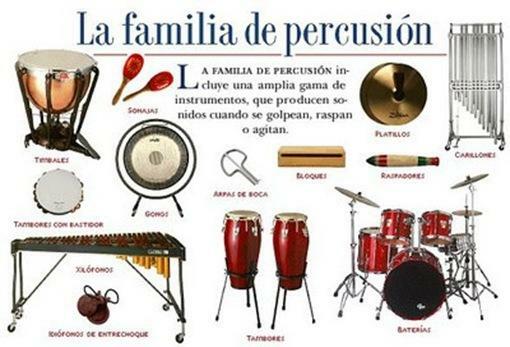
Image: En Clave de Niños
Types of percussion instruments.
We started talking about percussion musical instruments. Remember that this is the oldest type of instrument and, therefore, there is an impressive variety. Broadly speaking, we can categorize them into two main groups: Percussion instruments of undefined height Y defined height. This refers to whether the instrument has a specific tuning to create notes in addition to the rhythm or not.
Height-defined percussion instruments
As we mentioned, they are those who are hit without the intention of produce a note with defined pitch. Speaking of sound, technically this note will have a tuning (every sound has it), however it is irrelevant since its main function is not melodic but rhythmic or textural.
In this category we find the bass drum, the box, the cajon, the cymbals or cymbals, the tam tam, the harpsichord, the chestnuts, the maracas, the tambourine, the harpsichord, the bells and the güiro among others.
Percussion instruments of indefinite height
Unlike indefinite height instruments, many of these instruments can be used to create melodies such as the xylophone, glockenspiel (or lyre), vibraphone, and marimba. In the other case, they at least have the ability to support the sounds made by other instruments with melodic functions. Of these instruments we can mention the tubular bells, the bongos, the timpani and the toms of the drums.
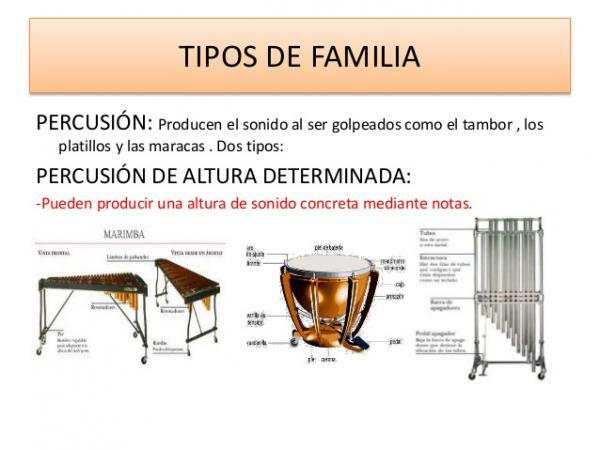
Image: Slideshare
Other categories of percussion musical instruments.
There is another way of classifying these instruments taking into account their method of sound production, some instruments can belong to several classifications at the same time.
- Membranophone Instruments: They have "membranes" sometimes called "patches" that are held and tensioned at different points at the ends. The tension can change affecting the type of sound it will produce. Examples: Timpani, bass drum, bongo, tambourine, congas.
- Idiophone Instruments: They are those whose sound is produced by the body of the instrument itself. Examples: triangle, maracas, cabasa, shekere, chestnuts, key.
- Placophone Instruments: They produce sound with metal "plates" colliding with each other. Examples: bass guitars, cymbals.
Percussion instruments of the world.
By the basic principle of percussion, there is great wealth As for a variety of instruments of this type in different parts of the world, many may not be conventional but they do turn out to be very interesting. We mention some in case you are curious: the tables (India), the djembé or yembé (Africa), the hang (Switzerland), kalimba (Africa), donkey jaw (Havana), rain stick (South America), cuica (Brazil), taiko (Japan).
Like many other things in music, percussion instruments are a world to explore. For years they have been related to strength and celebration, so if you intend to learn or know an instrument, you will likely have a great time with one of these.
If you liked reading this article by a TEACHER about percussion musical instruments, We invite you to leave a comment and to continue exploring the rest of the articles to your provision.
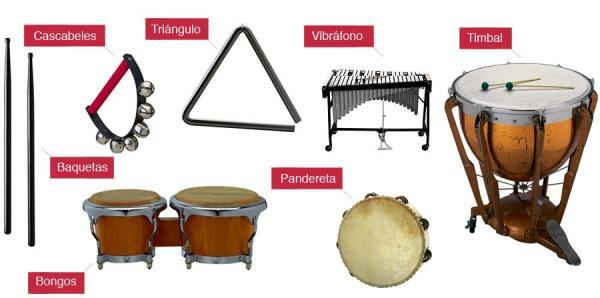
Image: Playtime
If you want to read more articles similar to Percussion musical instruments, we recommend that you enter our category of Musical instruments.

